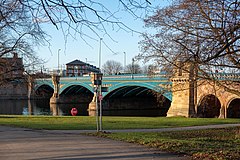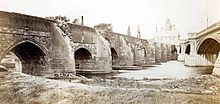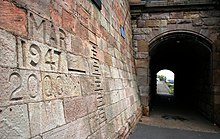Trent Bridge | |
|---|---|
 View of Trent Bridge from the bank of the River Trent, West Bridgford | |
| Coordinates | 52°56′18.4″N1°08′10.9″W / 52.938444°N 1.136361°W |
| Carries | Road traffic ( A60 , single carriageway) |
| Crosses | River Trent |
| Locale | Nottingham, Nottinghamshire, England |
| Heritage status | Grade II listed |
| Characteristics | |
| Material | Iron and stone |
| Width | 40 feet (12 m) |
| Longest span | 100 feet (30 m) |
| History | |
| Designer | Marriott Ogle Tarbotton |
| Constructed by | Andrew Handyside and Company |
| Construction start | 1868 |
| Construction end | 1871 |
| Location | |
 | |
Trent Bridge is an iron and stone road bridge across the River Trent in Nottingham, England UK. It is the principal river crossing for entrance to the city from the south, although the upstream Clifton Bridge is both larger and busier.





